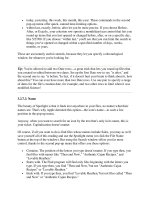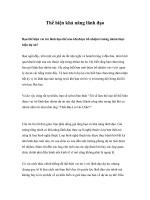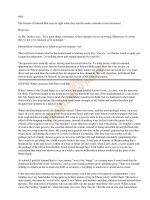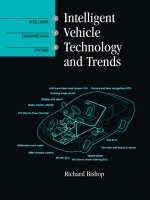Tài liệu The Advanced Technology Program: Assessing Outcomes pdf
Bạn đang xem bản rút gọn của tài liệu. Xem và tải ngay bản đầy đủ của tài liệu tại đây (1.07 MB, 329 trang )
CHARLES W. WESSNER, EDITOR
Board on Science, Technology, and Economic Policy
Policy and Global Affairs
National Research Council
NATIONAL ACADEMY PRESS
Washington, D.C.
The Advanced Technology Program:
Assessing Outcomes
NATIONAL ACADEMY PRESS • 2101 Constitution Avenue, N.W. • Washington, D.C. 20418
NOTICE: The project that is the subject of this report was approved by the Governing Board of the
National Research Council, whose members are drawn from the councils of the National Academy of
Sciences, the National Academy of Engineering, and the Institute of Medicine. The members of the
committee responsible for the report were chosen for their special competences and with regard for
appropriate balance.
This study was supported by Contract No. 50SBNB9C1080 between the National Academy of Sci-
ences and the National Institute of Standards and Technology. Any opinions, findings, conclusions,
or recommendations expressed in this publication are those of the author(s) and do not necessarily
reflect the views of the organizations or agencies that provided support for the project.
International Standard Book Number 0-309-07410-X
Limited copies are available from Board on Science, Technology, and Economic Policy, National
Research Council, 1055 Thomas Jefferson Street, N.W., Suite 2014, Washington, D.C. 20007; 202-
334-2200.
Additional copies of this report are available from National Academy Press, 2101 Constitution Av-
enue, N.W., Lockbox 285, Washington, D.C. 20055; (800) 624-6242 or (202) 334-3313 (in the Wash-
ington metropolitan area); Internet, .
Printed in the United States of America
Copyright 2001 by the National Academy of Sciences. All rights reserved.
iii
The National Academy of Sciences is a private, nonprofit, self-perpetuating society of
distinguished scholars engaged in scientific and engineering research, dedicated to the
furtherance of science and technology and to their use for the general welfare. Upon the
authority of the charter granted to it by the Congress in 1863, the Academy has a mandate
that requires it to advise the federal government on scientific and technical matters. Dr.
Bruce M. Alberts is president of the National Academy of Sciences.
The National Academy of Engineering was established in 1964, under the charter of
the National Academy of Sciences, as a parallel organization of outstanding engineers.
It is autonomous in its administration and in the selection of its members, sharing with
the National Academy of Sciences the responsibility for advising the federal govern-
ment. The National Academy of Engineering also sponsors engineering programs aimed
at meeting national needs, encourages education and research, and recognizes the supe-
rior achievements of engineers. Dr. William A. Wulf is president of the National Acad-
emy of Engineering.
The Institute of Medicine was established in 1970 by the National Academy of Sciences to
secure the services of eminent members of appropriate professions in the examination of
policy matters pertaining to the health of the public. The Institute acts under the responsibil-
ity given to the National Academy of Sciences by its congressional charter to be an adviser to
the federal government and, upon its own initiative, to identify issues of medical care, re-
search, and education. Dr. Kenneth I. Shine is president of the Institute of Medicine.
The National Research Council was organized by the National Academy of Sciences in
1916 to associate the broad community of science and technology with the Academy’s
purposes of furthering knowledge and advising the federal government. Functioning in
accordance with general policies determined by the Academy, the Council has become the
principal operating agency of both the National Academy of Sciences and the National
Academy of Engineering in providing services to the government, the public, and the
scientific and engineering communities. The Council is administered jointly by both Acad-
emies and the Institute of Medicine. Dr. Bruce M. Alberts and Dr. William A. Wulf are
chairman and vice chairman, respectively, of the National Research Council.
National Academy of Sciences
National Academy of Engineering
Institute of Medicine
National Research Council
v
*As of February 2001.
Steering Committee for Government-Industry Partnerships for the
Development of New Technologies
*
Gordon Moore, Chair
Chairman Emeritus
Intel Corporation
M. Kathy Behrens
Managing Partner
Robertson Stephens Investment
Management
and STEP Board
Michael Borrus
Managing Director
The Petkevich Group, LLC
Iain M. Cockburn
Professor of Finance and Economics
Boston University
Kenneth Flamm
Dean Rusk Chair
in International Affairs
LBJ School of Public Affairs
University of Texas at Austin
James F. Gibbons
Professor of Engineering
Stanford University
W. Clark McFadden
Partner
Dewey Ballantine
Burton J. McMurtry
General Partner
Technology Venture Investors
William J. Spencer, Vice-Chair
Chairman Emeritus
SEMATECH
and STEP Board
Mark B. Myers
Senior Vice-President, retired
Xerox Corporation
and STEP Board
Richard Nelson
George Blumenthal Professor of
International and Public Affairs
Columbia University
Edward E. Penhoet
Dean, School of Public Health
University of California at Berkeley
and STEP Board
Charles Trimble
Vice-Chairman
Trimble Navigation
John P. Walker
Chairman and Chief Executive Officer
Axys Pharmaceuticals, Inc.
Patrick Windham
President, Windham Consulting;
and Lecturer, Stanford University
vi
Charles W. Wessner
Study Director
Duncan Brown
Consultant
Project Staff*
McAlister T. Clabaugh
Program Associate
David E. Dierksheide
Program Associate
Contributors**
*
As of February 2001.
**Biographies of the contributors are included in Annex B.
David Austin
Resources for the Future
Alan P. Balutis*
National Institute of Standards and
Technology
Tayler H. Bingham
Research Triangle Institute
Jeffrey H. Dyer
Brigham Young University
Maryann P. Feldman
Johns Hopkins University
Maryellen R. Kelley*
National Institute of Standards and
Technology
Barbara Lambis
National Institute of Standards and
Technology
Albert N. Link
University of North Carolina at
Greensboro
Molly Macauley
Resources for the Future
Benjamin C. Powell
University of Pennsylvania
Rosalie Ruegg
Technology Impact Assessment
(TIA) Consulting
vii
*As of February 2001.
For the National Research Council (NRC), this project was overseen by the
Board on Science, Technology and Economic Policy (STEP), a standing board of
the NRC established by the National Academies of Sciences and Engineering and
the Institute of Medicine in 1991. The mandate of the STEP Board is to integrate
understanding of scientific, technological, and economic elements in the formu-
lation of national policies to promote the economic well-being of the United
States. A distinctive characteristic of STEP’s approach is its frequent interactions
with public and private-sector decision makers. STEP bridges the disciplines of
business management, engineering, economics, and the social sciences to bring
diverse expertise to bear on pressing public policy questions. The members of the
STEP Board
*
and the NRC staff are listed below:
Dale Jorgenson, Chair
Frederic Eaton Abbe Professor
of Economics
Harvard University
M. Kathy Behrens
Managing Partner
Robertson Stephens Investment
Management
Vinton G. Cerf
Senior Vice-President
WorldCom
Bronwyn Hall
Professor of Economics
University of California at Berkeley
James Heckman
Henry Schultz Distinguished Service
Professor of Economics
University of Chicago
Ralph Landau
Consulting Professor of Economics
Stanford University
Richard Levin
President
Yale University
William J. Spencer, Vice-Chair
Chairman Emeritus
SEMATECH
David T. Morgenthaler
Founding Partner
Morgenthaler
Mark B. Myers
Senior Vice-President, retired
Xerox Corporation
Roger Noll
Morris M. Doyle Centennial
Professor of Economics
Stanford University
Edward E. Penhoet
Dean, School of Public Health
University of California at Berkeley
William Raduchel
Chief Technology Officer
AOL Time Warner
Alan Wm. Wolff
Managing Partner
Dewey Ballantine
viii
*As of February 2001.
STEP Staff*
Stephen A. Merrill
Executive Director
Philip Aspden
Senior Program Officer
Camille M. Collett
Program Associate
David E. Dierksheide
Program Associate
Charles W. Wessner
Program Director
Craig M. Schultz
Research Associate
McAlister T. Clabaugh
Program Associate
viii
ix
National Research Council
Board on Science, Technology, and Economic Policy
Sponsors
The National Research Council gratefully acknowledges
the support of the following sponsors:
National Aeronautics and Space Administration
Office of the Director, Defense Research & Engineering
National Science Foundation
U.S. Department of Energy
Office of Naval Research
National Institutes of Health
National Institute of Standards and Technology
Sandia National Laboratories
Electric Power Research Institute
International Business Machines
Kulicke and Soffa Industries
Merck and Company
Milliken Industries
Motorola
Nortel
Proctor and Gamble
Silicon Valley Group, Incorporated
Advanced Micro Devices
Any opinions, findings, conclusions, or recommendations expressed in this
publication are those of the authors and do not necessarily reflect the views of
the project sponsors.
xi
Contents
FOREWORD 1
EXECUTIVE SUMMARY 3
I. PREFACE 11
II. INTRODUCTION 25
A. Background 25
B. Overview of the Papers 59
C. Summary of Symposium Proceedings 63
III. FINDINGS AND RECOMMENDATIONS 85
IV. PROCEEDINGS
Welcome 101
Charles Wessner, National Research Council
Introduction to the Symposium 103
Clark McFadden, Dewey Ballantine
Panel I: The ATP Objective: Addressing the Financing Gap for
Enabling Technologies 105
Moderator: Charles Trimble, Trimble Navigation
xii CONTENTS
The View from Industry: A Start-up’s Perspective 105
Elizabeth Downing, 3D Technology Laboratories
The Venture Capital Perspective 108
David Morgenthaler, Morgenthaler Venture Capital
Lowering Hurdle Rates for New Technologies 112
Kathleen Kingscott, International Business Machines
Corporation
Panel II: ATP’s Assessment Program 117
Moderator: David Goldston, Office of Congressman
Sherwood Boehlert
Delivering Public Benefits with Private-Sector
Efficiency Through the ATP 117
Rosalie Ruegg, Advanced Technology Program
Perspectives on Program Evaluation 123
Irwin Feller, Pennsylvania State University
Discussants: 126
Nicholas Vonortas, George Washington University
James Turner, House Science Committee
Panel III: Stimulating R&D Investment 131
Moderator: David Finifter, College of William & Mary
Assessing the ATP: Halo Effects and Added Value 131
Maryann Feldman, Johns Hopkins University
Cheap Gas?: Joint Ventures and Fuel Efficiency 136
Mark A. Ehlen, National Institute of Standards
and Technology
Design Freedoms and Enhanced Value 140
Larry Rhoades, Extrude Hone Corporation
Panel IV: Assessing Progress: Case Study Cluster 145
Moderator: David Austin, Resources for the Future
Xeno-Organ Transplant 146
David Ayares, PPL Therapeutics, Inc.
CONTENTS xiii
Extending Case Study Methodologies For Technology
Policy Evaluation 149
Todd A. Watkins, Lehigh University
Economic Returns to New Medical Technologies 154
Tayler Bingham, Research Triangle Institute
Discussant: Henry Kelly, White House Office of Science and 157
Technology Policy
Panel V: Assessing the ATP Assessment Program:
Challenges and Policy Issues 160
Moderator: Charles Wessner, National Research Council
Panelists: 160
John Yochelson, Council on Competitiveness
Maryann Feldman, Johns Hopkins University
William Bonvillian, Office of Senator Joseph Lieberman
David Goldston, Office of Congressman Sherwood Boehlert
Todd A. Watkins, Lehigh University
Concluding Remarks 169
Charles Wessner, National Research Council
Boxes within the Summary Report
Box A. Partnerships Reviewed by the Government-Industry
Partnerships Study 18
Box B. Principal Federal Legislation Related to Cooperative
Technology Programs 27
Box C. R&D Programs: The Challenge for Policymakers 34
Box D. What is the Advanced Technology Program? 40
Box E. Critical Characteristics of the Advanced Technology
Program 41
Box F. GAO Reviews of the ATP 45
Box G. “Picking Winners and Losers” and the Advanced
Technology Program 51
Box H. Why Should Government Fund Promising Technologies? 65
Box I. A Venture Capitalist’s Perspective on the ATP 66
Box J. Advancing the Art of Program Assessment 68
V. RESEARCH PAPERS
The ATP Competition Structure 175
Alan P. Balutis and Barbara Lambis, National Institute
of Standards and Technology
xiv CONTENTS
Leveraging Research and Development: The Impact of the
Advanced Technology Program 189
Maryann P. Feldman, Johns Hopkins University,
and Maryellen R. Kelley, National Institute of Standards
and Technology
Estimating Economic Benefits from ATP Funding of
New Medical Technologies 211
Tayler H. Bingham, Research Triangle Institute
Enhanced R&D Efficiency in an ATP-funded Joint Venture 223
Albert N. Link, University of North Carolina at Greensboro
Estimating Future Benefits from ATP Funding of Digital
Data Storage 239
David Austin and Molly Macauley, Resources for the Future
Perspectives on the Determinants of Success in ATP-sponsored
R&D Joint Ventures: The Views of Participants 249
Jeffrey H. Dyer, Brigham Young University,
and Benjamin C. Powell, University of Pennsylvania
Taking a Step Back: An Early Results Overview of
Fifty ATP Awards 259
Rosalie Ruegg, Technology Impact Assessment (TIA) Consulting
VI. ANNEX
A. Authorizing Legislation for the Advanced Technology
Program 281
B. Biographies of Contributors 287
C. Participants List
25 April 2000 Conference 295
D. Internal and External Reviews of the ATP, Analyses
Commissioned by the Office of Economic Assessment 299
E. Bibliography 303
1
The National Institute of Standards and Technology (NIST) asked the Na-
tional Research Council’s (NRC) Board on Science, Technology, and Economic
Policy (STEP) to review the operations of the Advanced Technology Program
(ATP) to ascertain if the program is achieving its legislated objectives and to
recommend potential improvements in its operations.
1
The ATP is a program administered by the Department of Commerce’s Na-
tional Institute of Standards and Technology to provide cost-shared funding to
industry to accelerate the development and broad dissemination of challenging,
high-risk technologies that promise broad-based economic benefits for the na-
tion.
2
The program seeks to support
• emerging and enabling technologies facing technical challenges, which, if
overcome, would contribute to the future development of new and sub-
stantially improved products, industrial processes, and services in diverse
areas of application;
Foreword
1
In Senate Report 105-235, the Advanced Technology Program was directed to arrange for a well-
regarded organization with significant business and economic experience to conduct a comprehensive
assessment of the ATP, analyzing how well the program has performed against the goals established
in its authorizing statute, the Omnibus Trade and Competitiveness Act of 1988. In January 1999 NIST
requested that the Board on Science, Technology, and Economic Policy conduct this assessment as
part of its broader review of Government-Industry Partnerships for the Development of New Tech-
nologies (described in the Preface).
2
The ATP was established in 1990 under the Omnibus Trade and Competitiveness Act of 1988
(P. L. 100-418), as amended by the American Technology Preeminence Act of 1991 (P. L. 102-245).
2 THE ADVANCED TECHNOLOGY PROGRAM: ASSESSING OUTCOMES
• technologies whose development often involves complex “systems” prob-
lems requiring a collaborative effort by multiple organizations;
• technologies that, because of their risk, or because firms are unable to
fully capture their benefits, are unlikely to be developed by individual
firms, or may proceed too slowly to compete in rapidly changing world
markets without the impetus of an ATP award.
3
The ATP provides a leading role for industry, balanced by government and out-
side expert review. Companies conceive, propose, co-fund, and execute all of the
projects. The ATP role is to identify the most promising projects that require
outside support and contribute to their development on a cost-shared basis.
This review of the ATP is being conducted under the auspices of the STEP
Board’s broader study of Government-Industry Partnerships for the Develop-
ment of New Technologies, a study designed to review and address the policy
issues associated with public-private collaboration to bring new technologies to
the market. It is widely recognized that new technologies make an important
contribution to economic growth while enhancing the capacity of the government
to perform major national missions in areas such as defense, the environment,
and health.
The NRC analysis in this report constitutes the second phase of the review
carried out under the Government-Industry Partnerships study. The first phase
report summarized a workshop designed to lay out the goals of the ATP, its
method of operation and evolution, the views of the program’s critics, and the
experiences of its users, that is, the winners of its competitive awards. This sec-
ond report includes five chapters in addition to the Executive Summary which
follows. Chapter I, the Preface, provides background information and describes
the Partnerships project and the goals of this study. Chapter II, the Introduction,
places the ATP in the context of U.S. technology policy and summarizes the
symposium and the commissioned papers. Chapter III provides the Committee’s
findings and recommendations concerning the performance and operation of the
program. Chapter IV provides a detailed summary of the proceedings from the
most recent National Research Council conference on the Advanced Technology
Program, which includes the perspective of administrators, company participants,
and analysts of the program. Chapter V includes six independent analyses illus-
trative of the ATP assessment program as well as a description of the current
selection process by NIST officials.
3
The ATP funds technical research but not product development.
3
Executive Summary
BACKGROUND
In response to a Senate mandate, the National Institute of Standards and Tech-
nology (NIST) asked the National Research Council (NRC) to review the perfor-
mance of the Advanced Technology Program (ATP) in light of its legislated goals
and to make recommendations for improvements, where appropriate, in the op-
erations of the program. This task was addressed by a committee previously
formed under the direction of the National Academies’ Board on Science, Tech-
nology, and Economic Policy (STEP) to carry out an assessment of government-
industry partnerships. The Committee responsible for this analysis was not
charged with a review of questions of principle with regard to the desirability of
government-industry cooperation. Recognizing that partnerships are an integral
part of the U.S. innovation system, the Committee has taken a pragmatic approach
focusing its work on the operation and assessment of government-industry part-
nerships.
1
Government-industry cooperation to achieve national goals has played a key
role in U.S. economic development.
2
Continued U.S. leadership in technological
1
The scope of the Committee’s work is described in the Preface.
2
See the overview of the history of government-industry collaboration in the Preface of this vol-
ume. As discussed in the Introduction, the U.S. government has played a significant and supportive
role in advancing technological progress in industries ranging from aircraft and biomedicine to infor-
mation technology and the Internet. The ATP is a public-private partnership to develop new tech-
nologies with broad applications. The program makes competitive awards on a cost-share basis to
individual companies and larger awards to joint ventures.
4 THE ADVANCED TECHNOLOGY PROGRAM: ASSESSING OUTCOMES
progress is essential for the long-term growth of the domestic economy at a rising
standard of living.
3
Substantial domestic U.S. investment in research and devel-
opment—both public and private—is the prerequisite for sustaining U.S. eco-
nomic growth in a global economy.
4
A leading role for the United States in the
development and commercialization of new technologies is essential to the con-
tinued competitive success of U.S. industry in global markets. Governments
around the world have recognized the importance of new technologies to their
economies and have encouraged public-private partnerships to develop and an-
chor them within their national economies. The long-term goal of these programs
is to achieve greater productivity growth through the creation of knowledge that
can be applied to industrial processes, products, and services.
5
The logic behind
government funding of certain types of R&D activities is that government awards
provide incentives to firms to undertake high-risk R&D projects with substantial
potential benefits for the economy as a whole.
6
In the middle of the 1980s the
United States began focusing more attention on cost-shared partnerships as a
means of developing new technologies.
As noted in the Introduction, the Committee’s assessment of the Advanced
Technology Program is contributing to the Committee’s review of government-
industry partnerships programs in the United States and abroad. This assessment
of the ATP should thus be understood as one element of the Committee’s multi-
year study of a wide variety of partnerships. Carrying out this analysis of the ATP
3
See Michael Borrus and Jay Stowsky, “Technology Policy and Economic Growth,” in Lewis
Branscomb and James Keller, editors, Investing in Innovation: Creating a Research and Innovation
Policy, Cambridge, MA: MIT Press, 1998. The contribution of technology to economic growth is
now well recognized. See P. Romer, “Endogenous Technological Change,” Journal of Political
Economy, 98(5):71-102, 1990. See also G. Grossman and E. Helpman, Innovation and Growth in the
Global Economy, Cambridge, MA: MIT Press, 1993.
4
Romer, “Endogenous Technological Change,” op. cit.; Borrus and Stowsky, “Technology Policy
and Economic Growth,” op. cit. See also National Research Council, Allocating Federal Funds for
Science and Technology, Washington, D.C.: National Academy Press, 1995. The report notes that
federal investments in R&D have produced enormous benefits for the nation’s economy, national
defense, health, and social well-being. Ibid, p. 3.
5
See the paper by Maryann P. Feldman and Maryellen R. Kelley, “Leveraging Research and
Development: The Impact of the Advanced Technology Program,” in this volume.
6
As noted by Feldman and Kelley in this volume, “The logic for public investment is that, in the
long run, the economic benefits to consumers, other firms and the larger national economy will ex-
ceed the private returns realized by the firm that received the research award, and thus justify the
public investment.” Ibid. The rationale for government funding of certain types of R&D activities, as
articulated by Zvi Griliches, is that this funding encourages firms to undertake R&D projects in which
the public rate of return exceeds the private rate of return. This includes, for example, the case in
which an industry as a whole may benefit from the development of an enabling technology. Private
firms typically use some predetermined benchmark rate of return known as a hurdle rate. The project
will only be acceptable if the expected rate of return is above that benchmark. By reducing the cost
of the project, government funding will increase the expected rate of return and may make private
companies willing to pursue them. See Z. Griliches, “The Search for R&D Spillovers,” Scandinavian
Journal of Economics, 94(Supplement):29-47.
EXECUTIVE SUMMARY 5
has informed the Committee’s deliberations and allowed for comparative points
of view on a range of partnership activities. As part of this assessment, the Com-
mittee organized two major symposia and a workshop to review the program’s
operation and also drew on the substantial body of independent analysis of the
program. The initial symposium provided an overview of the program in terms of
its goals, operations, assessment, achievements, and challenges while providing
an opportunity for critics to voice their views. The symposium summarized in
this volume focused on possible improvements to the program, findings from the
ATP assessment effort, issues such as “crowding out” and the relationship of the
ATP to venture capital, the roles and needs of large companies in such a program,
and feedback from users, some of whom have received other types of awards.
The collection of papers included in this volume provide insights into the opera-
tion and impact of the ATP and are illustrative of the substantial program of
external and internal research it has under way. The meetings and research are of
course complemented by the exceptional expertise of the Committee responsible
for the NRC review of government-industry partnerships.
7
Keeping in mind the
limitations and advantages of the Committee’s analysis, the core findings and
recommendations of the study are listed below.
CORE FINDINGS AND RECOMMENDATIONS
8
1. The Committee finds that the Advanced Technology Program is an effec-
tive federal partnership program. The selection criteria applied by the
program enable it to meet broad national needs and help ensure that the
benefits of successful awards extend across firms and industries. Its cost-
shared, industry-driven approach to funding promising new technological
opportunities has shown considerable success in advancing technologies
that can contribute to important societal goals such as improved health
diagnostics (e.g., breast cancer detection), developing tools to exploit the
human genome (e.g., colon cancer protection), and improving the effi-
ciency and competitiveness of U.S. manufacturing.
9
7
The members of the Committee are listed in the front matter.
8
These summary findings and recommendations are elaborated and documented in Chapter III of
this volume. In addition to the papers and proceedings in this volume, the Committee issued National
Research Council, The Advanced Technology Program: Challenges and Opportunities, Washington,
D.C.: National Academy Press, 1999. The ATP assessment program also provides extensive docu-
mentation regarding the contributions of the program. See Annex D in this volume. See also William
F. Long, Advanced Technology Program: Performance of Completed Projects: Status Report Num-
ber 1, NIST Special Publication 950-1, March 1999.
9
See Section I in Chapter III of this volume. For a summary of the differentiating characteristics
of the ATP, see Maryann Feldman’s analysis in Section C of the Introduction and the study by Feldman
and Kelley, “Leveraging Research and Development: The Impact of the Advanced Technology Pro-
gram,” both in this volume.
6 THE ADVANCED TECHNOLOGY PROGRAM: ASSESSING OUTCOMES
10
With regard to the ATP selection process see the presentation by former ATP Director, Lura
Powell, in the first volume of this study, National Research Council, The Advanced Technology
Program: Challenges and Opportunities, op. cit., pp. 53-56; with regard to the role of venture capital
finance and the need for a bridging mechanism, see the statement by Todd Spener of Charter Finan-
cial in the same volume, pp. 90-91, as well as the presentation by Joshua Lerner of the Harvard
Business School, pp. 88-90. See also the presentation by venture capitalist David Morgenthaler in
Panel I of the Proceedings of this volume and the summary of his statement in Section C of the
Introduction to this volume. See also Lewis M. Branscomb and Philip E. Auerswald, Taking Techni-
cal Risks: How Innovators, Managers and Investors Manage Risk in High-Tech Innovation, Cam-
bridge: MIT Press, 2001, Chapter 5 and passim.
11
See Section I in Chapter III of this volume and the description of the program, its current results,
and the ATP assessment effort by Rosalie Ruegg and the positive review of the assessment program
by Irwin Feller of Pennsylvania State University in Panel II in this volume. See also the panel
discussion led by Richard Nelson of Columbia University, including the description of the ATP as-
sessment, its early beginnings, and its focus on tools for assessing technology spillovers in National
Research Council, The Advanced Technology Program: Challenges and Opportunities, op. cit., pp.
71-80.
12
See, for example, the paper by Maryann Feldman and Maryellen Kelley, “Leveraging Research
and Development: The Impact of the Advanced Technology Program,” in this volume. The study by
Albert N. Link, “Enhanced R&D Efficiency in an ATP-funded Joint Venture,” documents the impact
of an ATP joint venture designed to reduce the costs and timing required to develop a suite of new
technologies for the U.S. printed wiring board industry. The study finds a dramatic effect on R&D
efficiency, resulting in cost savings on the order of $35 million while reducing cycle times for new
product and process development. The project resulted in productivity improvements for member
companies, diffusion of new technology to other producers, and improved competitive positions for
and retained employment at participating companies. The study by David Austin and Molly Macauley,
“Estimating Future Benefits from ATP Funding of Digital Data Storage,” estimates substantial con-
sumer welfare gains from ATP-funded innovations in digital data storage although the final impact is
dependent on the adoption of the technologies. Similarly, the paper by Tayler H. Bingham, “Estimat-
ing Economic Benefits from ATP Funding of New Medical Technologies,” projects substantial social
returns, much larger than the projects’ private returns, primarily due to the projected positive spillovers
to patients treated with new technologies. These technologies focus on the diagnosis and treatment of
cancer; the treatment of diabetes, damaged ligaments and tendons; and the transplanting of xenogenic
organs. The overview of the progress of ATP awards by Rosalie Ruegg, “Taking a Step Back: An
Early Results Overview of Fifty ATP Awards,” documents both commercialization progress and
2. The program’s peer review of applicants for both technical feasibility and
commercial potential supports its goal of helping advance promising new
technologies that are unlikely to be funded through the normal operation
of the capital markets.
10
3. The program has set a high standard for assessment involving both inter-
nal and independent external review. The quality of this assessment effort
lends credence to the program’s evaluation of its accomplishments.
11
4. The extensive assessments of the program show that it appears to have
been successful in achieving its core objective, that is, enabling or facili-
tating private sector R&D projects of a type, or in an area, where social
returns are likely to exceed private returns to private investors.
12 ,13
EXECUTIVE SUMMARY 7
5. The Committee does recommend a series of operational improvements
designed to make this program more effective and suggests several mea-
sures designed to bring the benefits of the ATP to other national initia-
tives and to state technology programs through enhanced cooperation.
14
knowledge creation and dissemination. The latter is documented through outside recognition of the
project’s technical accomplishments, patents filed and granted, patent-tree citations, collaborative
relationships, and knowledge disseminated through new products and processes. Ruegg records sub-
stantial evidence that benefits are extending well beyond those captured by award recipients. The
papers cited above are included in this volume.
13
For an excellent review of the factors affecting the generation and impact of social returns or
spillovers, see Adam B. Jaffe, Economic Analysis of Research Spillovers: Implications for the Ad-
vanced Technology Program, NIST GCR 97-708, December 1996. For additional ATP-supported
research on social benefits, see Edwin Mansfield, Estimating Social and Private Returns from Inno-
vations Based on the Advanced Technology Program: Problems and Opportunities, NIST GCR 99-
780, January 1996; William F. Long, Performance of Completed Projects, Status Report Number 1,
op. cit.; Wesley M. Cohen and John Walsh, R&D Spillovers, Appropriability, and R&D Intensity: A
Survey-Based Approach, Gaithersburg, MD: National Institute of Standards and Technology, Forth-
coming; and Michael S. Fogarty, Amit K. Sinha, and Adam B. Jaffe, ATP and the US Innovation
System: A Methodology for Identifying Enabling R&D Spillover Networks with Application to
Microelectro-mechanical Systems (MEMS) and Optical Recording, Gaithersburg, MD: National In-
stitute of Standards and Technology, Forthcoming.
14
See Sections II and III in Chapter III of this volume.
I
PREFACE
10









